Impact of Environmental Exposure on the Structure and Integrity of the Hair Fiber: A Pilot Study Using SEM and Mechanical Parameters
Assessing the impact of environmental factors on hair is key to understanding hair damage and developing protective and restorative solutions. This pilot study by Zurko Research analyzed the structure and mechanical properties of hair exposed for 45 days to three outdoor natural environments and one artificially polluted environment with carbon-based contamination. Using SEM, tensile strength tests, combing force, lightness (L*), and split ends evaluation, significant structural damage was detected, especially under artificial pollution. The results support the development of anti-pollution products and standardized testing protocols.
Introduction
Although biologically inert, human hair directly reflects the cumulative effects of the environment. Factors such as solar radiation, air pollution, wind, and humidity leave visible marks on the hair fiber including loss of shine, dull color, rough texture, and increased fragility. In this context, the concept of the “exposome” has become a key framework for understanding how lifetime environmental exposures influence human health and appearance, including the skin and hair [1].
Originally proposed by Wild in 2005 [2], the exposome refers to the total set of non-genetic exposures an individual experiences from conception to death [2]. More recently, research has evolved toward the development of dynamic strategies to characterize these exposures through personal monitoring and environmental biomarker analysis [3]. In dermatology, the exposome has proven particularly useful for explaining mechanisms associated with skin aging, hyperpigmentation, and alterations of the scalp and hair follicle [4].
In the specific case of hair, recent studies have shown how factors such as UV radiation, air pollution, and extreme humidity can affect its color, texture, and strength [5]. These exposures can induce oxidation processes, protein denaturation, and damage to the hair cuticle, resulting in both visual and functional impacts on the fiber [4],[5].
Consumers are increasingly aware of these effects. In today’s context, there is growing demand for cosmetic products that not only restore but also prevent environmental damage. This highlights the importance of using objective scientific tools to evaluate the exposome’s impact on hair health and how it can be mitigated through cosmetic strategies [2],[6].
Therefore, this study aims to evaluate, in a controlled manner, the exposure of human hair to different environments representative of the exposome, from densely populated urban areas to artificially polluted settings, and to analyze their structural, mechanical, and optical consequences using standardized and reproducible techniques.
Materials and Methods
In this experimental study, natural human hair tresses of Caucasian origin were selected, with no prior treatments (uncolored, unbleached, and not chemically straightened), and with homogeneous characteristics in terms of color, diameter, and length. Baseline conditions were standardized as follows: each tress was cut into segments of approximately 25 cm in length and 3 g in weight, and prewashed with a neutral shampoo to remove any residues of cosmetic products or prior contaminants.
After washing, the tresses were air-dried under controlled conditions of temperature (22 ± 3 °C) and humidity (50 ± 5%) for 24 hours. They were then randomly divided into four experimental groups, each consisting of five individual tresses (n = 5 per group), and subjected to different environmental exposure conditions:
- Group 1: Exposure in a high-density urban environment, in the city of Barcelona, characterized by high levels of air pollution and heavy vehicle traffic.
- Group 2: Exposure in a low-density urban environment, in the metropolitan area of Barcelona, with moderate pollution levels.
- Group 3: Exposure in a low-density rural environment, in the central region of Spain, representing a clean setting with minimal industrial activity.
- Group 4: Artificial exposure in laboratory conditions, through surface deposition of carbon particles generated by contact with the contaminant.
For Groups 1 to 3, the hair tresses were mounted on vertical support structures and placed on terraces or open-air locations. Environmental exposure was maintained continuously for 45 days, covering the months of January and February, which involved varying weather conditions. In the urban coastal areas, temperatures ranged from 5 °C to 18 °C, with high relative humidity levels (up to 92%) and moderate UV indices (2–4). In contrast, the rural environment where Group 3 was exposed recorded lower minimum temperatures (down to –2 °C) and significantly lower humidity, with values dropping to 39%. These environmental differences, especially in humidity and temperature range, provide context for the type of physical or chemical stress that may have affected the surface and structure of the hair fiber.
For Group 4, the tresses were placed in a sealed exposure chamber, where an artificial pollution protocol was applied under stable temperature and ventilation conditions.
After the exposure period, all tresses underwent a climate conditioning process for 24 hours (22 °C, 50% RH) prior to measurement.
Finally, all hair tresses were analyzed using the following methodologies: First, scanning electron microscopy (SEM) was used to examine the morphology of the cuticle, allowing for the detection of structural alterations or the presence of adhered particles. Functionally, tensile strength tests were conducted to measure the force required to break individual fibers. In parallel, combing force was evaluated using a standardized system to quantify surface friction and resistance to detangling. For visual aspects, a colorimetric analysis focused on the L* parameter of the CIELAB system was carried out, which detects changes in hair lightness, such as brightening or darkening after exposure. Finally, an optical inspection of the ends of each tress was performed to record the appearance of new split ends, indicative of progressive physical damage.
All analyses were conducted under reproducible conditions using calibrated instruments and specialized technical personnel.
Once the data were collected, descriptive statistical analysis was performed to characterize the variables included in the study. Variables were described using means and standard deviations (SD), given their continuous nature.
To evaluate differences between groups, statistical tests were applied based on the normality distribution of the variables, which was assessed using the Shapiro-Wilk test. When normality was assumed, Student’s t-test for independent samples was used; when normality assumptions were not met, the non-parametric Wilcoxon test was applied.
Additionally, mixed linear models were used to analyze longitudinal or dependent data, taking into account both random and fixed effects based on the structure of the study. This approach allowed for consideration of intra-sample variability and improved the estimation of main effects.
The level of statistical significance was set at p < 0.05. All analyses were performed using R software (version 4.4.2, released on October 31, 2024; UCRT platform).
Results and Discussion
The results obtained through scanning electron microscopy (SEM) provided detailed insights into the structural alterations of the hair cuticle following exposure to different environmental conditions.
In Group 1 (high-density urban environment), the images revealed a severely deteriorated cuticle. Deep fissures were observed on the surface, along with detachment of cuticle layers and significant accumulation of pollutant particles. The hair surface displayed an irregular texture with visible microfractures, indicating a high degree of erosion and accumulated environmental damage.
Group 2 (low-density urban area) showed a relatively preserved cuticle. The cuticular scales were well-defined and organized, although minor imperfections such as slight lifting or eroded edges were present. Overall, the structure remained coherent, with no signs of deep damage or significant deposits.
In Group 3 (rural environment), the SEM images revealed a continuous and well-structured cuticle. The scales were fully adhered, arranged in regular patterns, and exhibited a smooth surface, with no evidence of marked erosion. The presence of pollutant particles was minimal, suggesting a clean and non-aggressive environment for the hair fiber. This condition corresponded with a relatively smooth and clean surface, without relevant morphological alterations.
Finally, Group 4 (artificial exposure to carbon particles) exhibited the highest degree of surface alteration. The cuticle appeared heavily damaged, with extensive fissures, loss of layers, and clear signs of erosion. A massive adhesion of pollutants was evident on the surface, giving the fiber an extremely rough and altered appearance. This condition replicated a scenario of severe pollution, where contaminants were visibly and extensively fixed to the hair fiber.
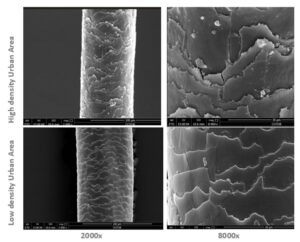
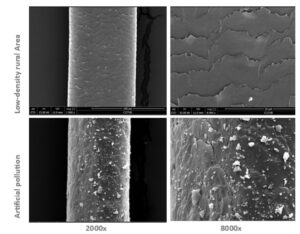
Figure 1. Scanning electron microscopy (SEM) images of the hair surface after 45 days of exposure to different environments. Magnifications of 2000x and 8000x are shown for each group: high-density urban environment, low-density urban environment, low-density rural environment, and artificial pollution exposure. Differences in cuticle integrity and the presence of adhered particles are observed depending on the environmental setting.
These morphological observations provide direct visual evidence of the differential effect that environmental settings have on the structural health of hair, and they support the findings from subsequent mechanical and optical analyses.
Regarding tensile strength, the results showed clear differences between the exposure groups. Group 1, corresponding to the high-density urban environment, exhibited the lowest average tensile strength (8.52 mN), which aligns with the structural damage observed in the SEM analysis. Unexpectedly, Group 2 (low-density urban environment) recorded the highest tensile strength (10.04 mN), even surpassing the rural group. This may be related to a balance between slight environmental stimulation and a pollution level that is not high enough to cause significant deterioration. The difference with Group 3 (rural environment), which reached an average value of 9.65 mN, was not statistically significant, reinforcing the hypothesis that both environments provide more favorable conditions for preserving hair fiber integrity.
Meanwhile, Group 4, which underwent controlled artificial pollution exposure with carbon particles, showed slightly lower strength (9.31 mN) compared to Groups 2 and 3. This result confirms the weakening effect of pollutants on the hair structure, even when applied under controlled and localized conditions.
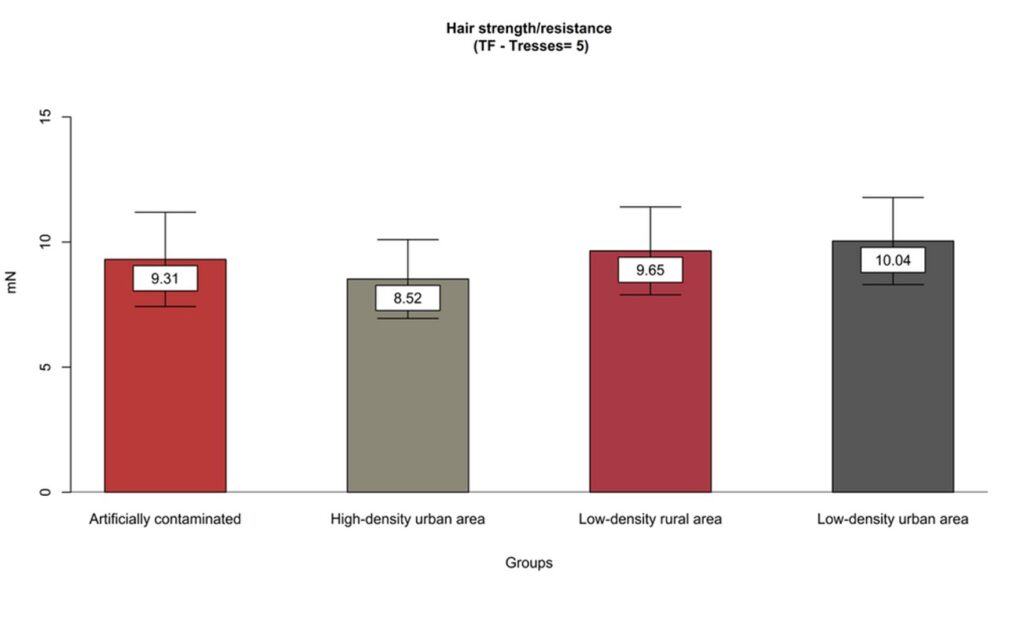
Figure 2. Results of the hair tensile strength test (maximum force, mN) after 45 days of exposure under four environmental conditions: artificial pollution, high-density urban environment, low-density rural environment, and low-density urban environment. A lower strength is observed in the group exposed to the dense urban environment, while the low-density urban group reached the highest values.
In the evaluation of hair smoothness through combing force measurement, the results revealed significant differences between the groups. Group 4, exposed to artificial contamination with carbon particles, exhibited the highest combing resistance, indicating elevated surface friction. This increase in the force required to detangle the hair fibers suggests a loss of natural smoothness, likely due to the accumulation of surface contaminants and cuticle degradation, resulting in a rougher and less slippery texture.
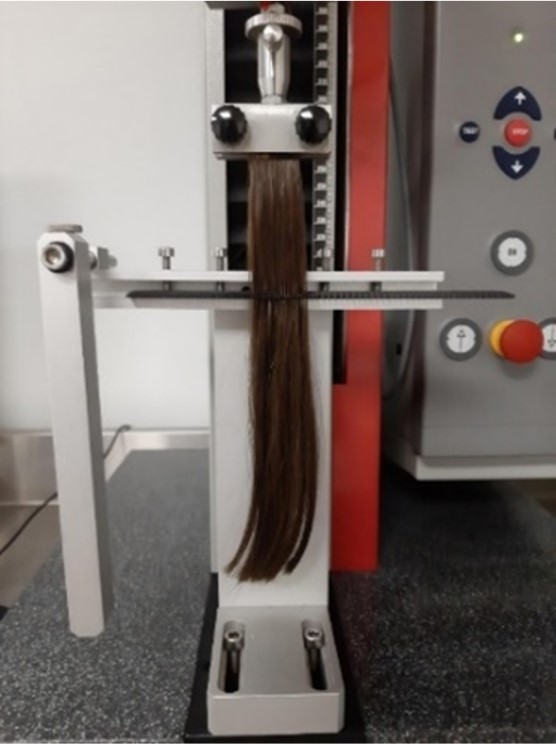
Figure 3. Device used for measuring combing force to assess hair smoothness. The system quantifies detangling resistance by passing a hair tress through a fixed comb in a controlled manner, recording the force required for displacement.
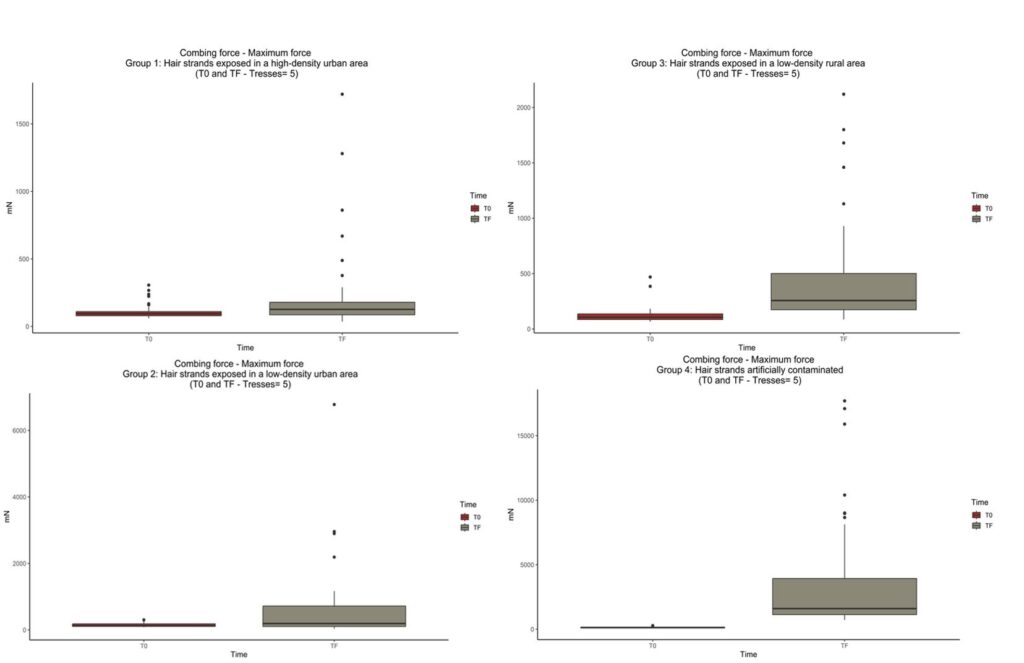
Figure 4. Results of maximum combing force (N) before and after exposure in the four experimental groups. An increase in surface friction is observed in the rural and artificial groups, reflecting a loss of hair smoothness after exposure.
Group 3 (rural environment) also showed an increase in combing force compared to the urban groups. Although it did not present severe morphological damage like the artificial group, this increase may be linked to physical factors such as wind exposure, which is characteristic of open rural areas. The constant movement of the fibers outdoors may have promoted mechanical entanglement of the hair and greater contact between cuticles, causing additional friction even in the absence of significant pollution.
In contrast, Groups 1 and 2 (urban environments with high and low population density, respectively) showed lower combing force values, indicating better preservation of surface smoothness. Despite the structural damage observed in Group 1 at the cuticle level, it is possible that the loss or erosion of cuticle scales resulted in a relatively smoother surface, reducing apparent friction during combing.
Regarding color evaluation, the L* parameter was analyzed as an indicator of lightness, reflecting changes in the visual perception of the hair after environmental exposure. The results showed a significant increase in L* in Groups 1, 2, and 3, corresponding to natural exposures, indicating a progressive lightening of the hair color. This phenomenon is consistent with oxidation processes induced by UV radiation or prolonged outdoor exposure, which affect the hair’s natural pigments, making it appear lighter and less saturated.
In contrast, Group 4, exposed to artificial contamination with carbon particles, experienced a marked reduction in the L* value (−12%), indicating a visible darkening of the hair fiber. This change is primarily attributed to the superficial adherence of contaminants, which alters both light reflection and the visual perception of the hair, giving it a duller and less luminous appearance.
Regarding the evaluation of new split ends, no significant differences were observed compared to the initial conditions or between groups, suggesting that the 45-day exposure period was not sufficient to induce this type of damage.
Conclusion
This study confirms that short-term environmental exposure can visibly and functionally affect the hair fiber. Pollution causes both structural and optical damage.
A global comparison of the results obtained across the different exposure groups reveals consistent patterns between the type of environment and its impact on the hair fiber.
In the case of the group exposed to the high-density urban environment, the combination of elevated air pollution, moderate UV radiation, and high humidity appeared to have a synergistic negative effect on the hair. This resulted in visible cuticle deterioration (deep fissures, scale loss), a significant reduction in mechanical strength, and a progressive lightening of hair color, likely due to UV-induced oxidation in a context of accumulated pollution. Despite the morphological damage, surface friction was moderate, possibly due to cuticle wear that temporarily “smooths” the hair surface.
On the other hand, the low-density urban environment yielded surprisingly favorable results. It maintained good structural integrity and the highest tensile strength, suggesting that controlled exposure without extreme pollutant levels might not be harmful and could even help preserve certain aspects of hair’s functional integrity.
Interestingly, rural exposure increased combing resistance, probably due to mechanical factors such as wind. Although the cuticle structure remained nearly intact and the fiber showed high levels of lightness, increased friction during combing was detected.
Artificial pollution caused the most extreme changes, especially in surface texture and color, highlighting the need for protective products in high-exposure contexts and reinforcing the value of this model as a standardized method for simulating extreme pollution-related damage.
Overall, these results demonstrate how different components of the exposome, whether chemical, physical, or atmospheric, affect the hair fiber in distinct ways. They also reinforce the importance of developing products that not only repair damage but also prevent and protect according to the specific environmental conditions to which the user is exposed.
References
[1] Passeron, T. et al. “Clinical and biological impact of the exposome on the skin.” Journal of the European Academy of Dermatology and Venereology (JEADV), vol. 34 Suppl 4 (2020): 4–25. doi:10.1111/jdv.16614.
[2] Wild, Christopher Paul. “Complementing the genome with an ‘exposome’: the outstanding challenge of environmental exposure measurement in molecular epidemiology.” Cancer Epidemiology, Biomarkers & Prevention, vol. 14, no. 8 (2005): 1847–1850. doi:10.1158/1055-9965.EPI-05-0456.
[3] Jiang, Chao et al. “Dynamic Human Environmental Exposome Revealed by Longitudinal Personal Monitoring.” Cell, vol. 175, no. 1 (2018): 277–291.e31. doi:10.1016/j.cell.2018.08.060.
[4] Krutmann, Jean, et al. “The skin aging exposome.” Journal of Dermatological Science, vol. 85, no. 3 (2017): 152–161.
[5] Cedirian, Stephano et al. “The exposome impact on hair health: non-pharmacological management. Part II⋆.” Anais Brasileiros de Dermatologia, vol. 100, no. 2 (2025): 322–327. doi:10.1016/j.abd.2024.08.006.
[6] Rappaport, S.M. & Lioy, P.J. “An Integrated Approach to the Exposome: Rappaport and Lioy Respond.” Environmental Health Perspectives, vol. 120, no. 3 (2012): a104. doi:10.1289/ehp.1104719R. PMCID: PMC3295362.

Company: Zurko Research S.L.
E-mail: info@zurkoresearch.com
Tel: +34 915 211 588
Website: www.zurkoresearch.com
LinkedIn: www.linkedin.com/company/zurkoresearch
Contact us for more info!







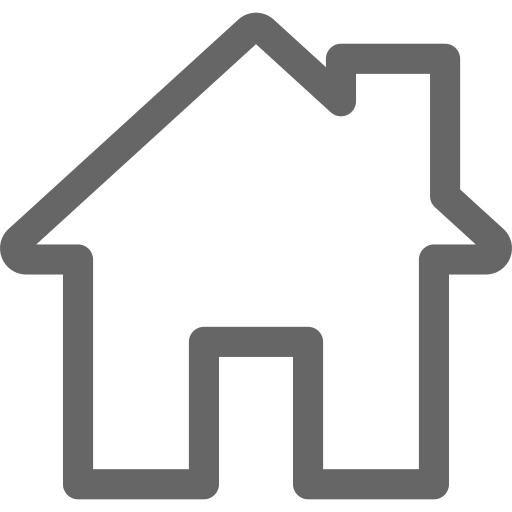 |
| 



